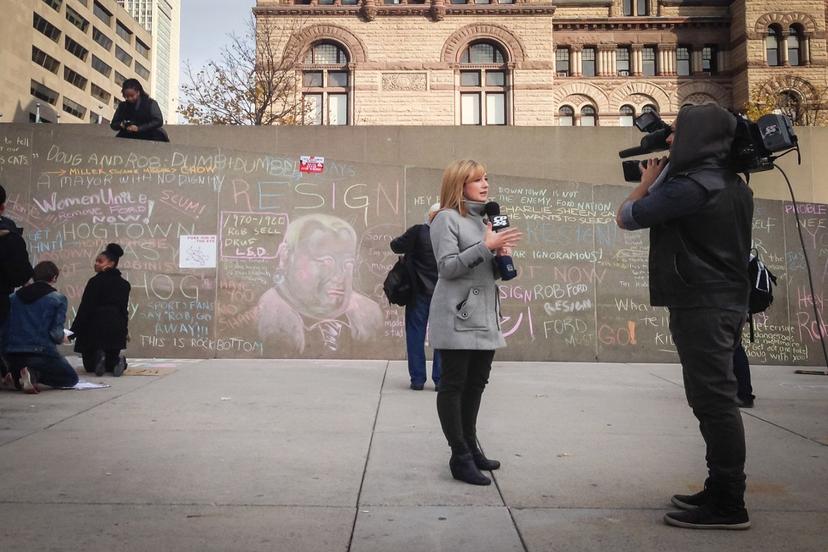Journalism

Structure
The outlook for newspapers was bleak at the end of the decade. In 2018, weekday circulation reached 28.6 million, while Sunday circulation totaled 30.8 million, according to the Pew Research Center. These reflected declines of 8 percent and 9 percent from 2017, respectively. Circulation of printed newspapers experienced more significant declines (12 percent and 13 percent, respectively). "Newspapers are a critical part of the American news landscape, but they have been hit hard as more and more Americans consume news digitally," the organization explained. "The industry's financial fortunes and subscriber base have been in decline since the mid-2000s, and website audience traffic, after some years of growth, has leveled off."
Television has long been Americans' preferred medium for news, but broadcast stations (as opposed to cable) have long assumed that people will watch news only if there is nothing else to watch. This is why these stations follow the practice of offering daily news shows only in early-morning and late-night time slots, where their main competition is other news broadcasts. Although the popularity of local news has been declining, especially among young people, about 38 percent of Americans watch it regularly. Cable news commands a smaller audience: 34 percent say they are regular viewers. The trend for cable news, as for the newspapers, is toward an older audience. Fox News, which targets the older demographic, is the most popular cable news channel, followed by MSNBC and CNN.
Digital platforms have become a news source for most Americans. In addition to accessing legacy news outlets (which originated in print but now offer digital content as well), the popularity of digital-native publishers (those that originated online) was growing at the end of the decade. In the fourth quarter of 2018, an estimated 22.4 million unique monthly visitors frequented the primary domains of digital-native publishers, up from nearly 19.0 million during the fourth quarter of 2014, according to Pew Research.
All of these outlets for news depend on material supplied by journalists—reporters, correspondents, and news analysts—and assigned and processed by editors.
The Bureau of Labor Statistics estimates that about 42,800 Americans are working as reporters and correspondents, including freelancers. Of that, 44 percent work for newspapers, 28 percent for radio and television broadcasting, and 9 percent in other information services.
The work requires good writing ability, plus good speaking skills for live radio and television reporting. Employers usually expect job candidates to have a bachelor's degree, plus experience working on a college newspaper or in an internship position. Bachelor's programs in journalism or communications provide useful writing skills and an understanding of journalistic ethics. For specialized reporting on topics such as science or business, an appropriate degree or work experience is helpful or even required. Working with news sources demands good people skills and sometimes persistence. Even though many electronic media are not "put to bed" at a certain hour, as newspapers are, the news must be timely, so journalists usually work to meet a deadline, sometimes putting in long hours.
Because the news can often involve complex issues, with economic, social, legal, scientific, and other implications, news consumers often appreciate analysis to fit the news into these contexts and, perhaps, to provide an understanding that is consistent with a certain world-view. News analysts, also known as commentators or columnists, need a higher level of knowledge, experience, and writing skill than the average reporter to successfully put the news into context.
The BLS differentiates between journalists in all media and news analysts who work in broadcasting. The latter occupation consists of about 6,900 workers, of whom 71 percent work in radio and television, 13 percent are self-employed, and 3 percent work for educational services. This group of workers includes those who report on the weather, corporate mergers, and the deliberations of the Supreme Court, interpreting complex news for a general audience.
Although some news is reported live and unfiltered as it happens, news editors still review journalists' writing. Copy editors improve the wording, make sure that ethical standards are upheld, and match photos, video, and text appropriately. The executive editor assigns stories and decides which stories to run; the managing editor supervises the entire operation of the news department. Editors experience the same deadline pressures that journalists do, and they typically come from a similar background. Often they arrive at their present position after experience as a journalist. They need to be familiar with means of electronic communication to stay in touch with reporters, and they should be skilled with electronic publishing and multimedia production, now that so much news is distributed digitally. About 47,500 editors work for newspaper, periodical, book, and directory publishers.
A few hundred photographers, videographers, and video editors also are employed to shoot news events and edit the material for distribution. Many of them have bachelor's degrees in their specialized field, and a good eye for visual storytelling is also important.
